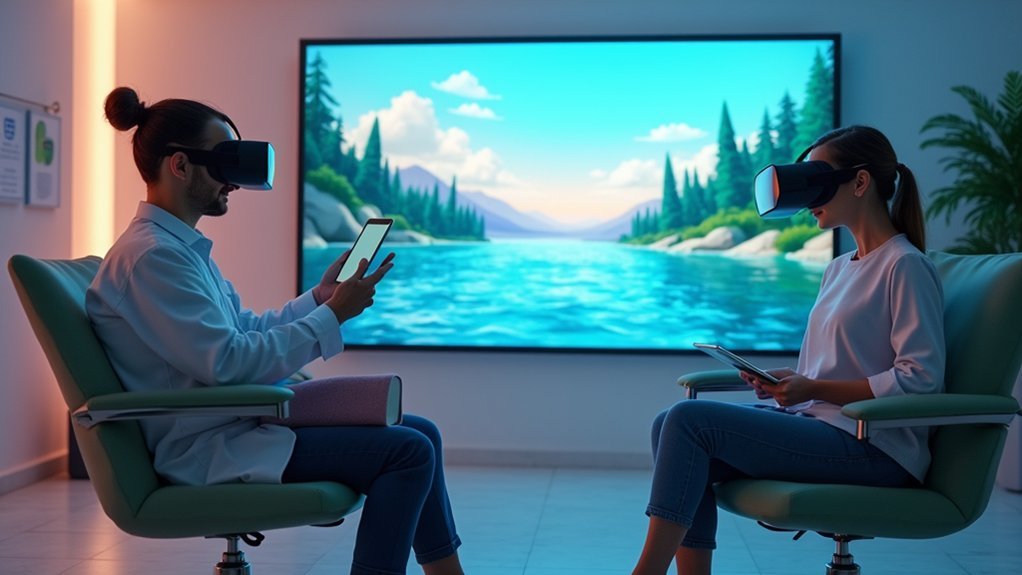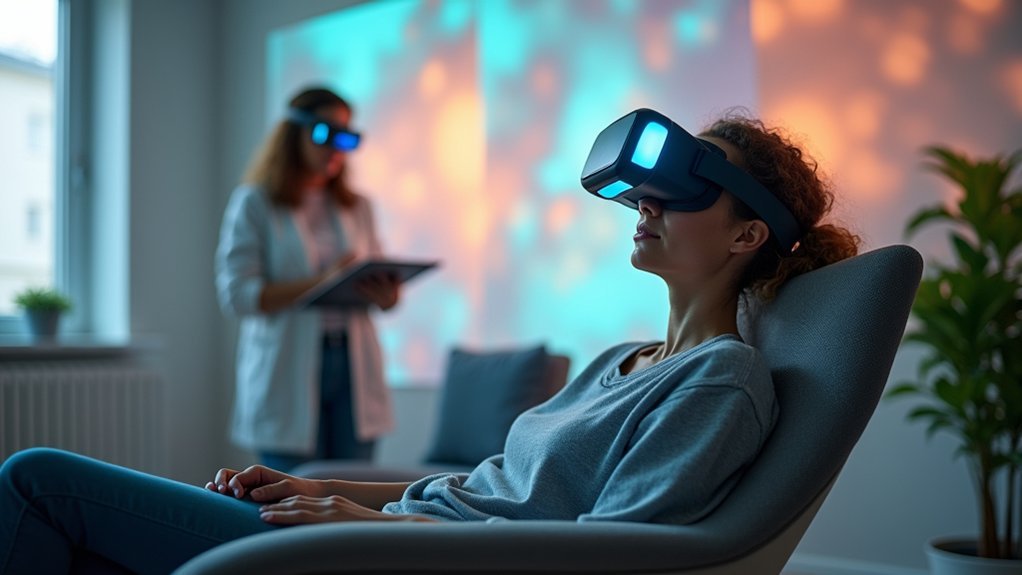You’ll experience revolutionary rehabilitation through virtual reality therapy that transforms traditional recovery methods into immersive, engaging environments. VR reduces chronic pain perception by 24% and accelerates motor function recovery by up to 30%, particularly benefiting stroke patients who show remarkable improvements in upper limb mobility. The technology gamifies therapy sessions, boosting patient engagement by 80% while strengthening neuroplasticity through repetitive, interactive challenges. Continue exploring to uncover implementation strategies and measurable outcomes.
Understanding Virtual Reality Therapy in Medical Settings

While traditional rehabilitation methods rely on repetitive exercises that can feel monotonous, Virtual Reality Therapy (VRT) transforms patient recovery by immersing you in engaging, three-dimensional environments that make healing feel more like an interactive experience than a medical procedure.
When you wear a VR headset, you’ll encounter carefully designed virtual scenarios that simulate real-world tasks, enabling you to practice motor functions and cognitive skills in controlled settings. This approach markedly improves patient engagement and motivation throughout your rehabilitation journey.
Healthcare providers can monitor your progress through integrated measurement tools that track performance in real-time, creating personalized treatment plans.
Studies demonstrate VRT’s effectiveness, showing a 24% reduction in chronic pain perception while delivering enhanced treatment outcomes across various medical conditions.
How VR Technology Creates Immersive Healing Environments
Through sophisticated computer graphics and spatial audio technology, VR systems construct convincing three-dimensional worlds that trick your brain into believing you’re actually present in these therapeutic environments.
VR technology uses advanced graphics and audio to create immersive therapeutic worlds that convince your brain you’re truly present.
Virtual reality technology creates immersive environments that transform traditional rehabilitation approaches by engaging multiple sensory channels simultaneously.
These therapeutic scenarios offer several key advantages:
- Enhanced cognitive rehabilitation through interactive simulations that mirror real-world activities and challenges
- Improved pain management by creating compelling distractions that reduce pain perception by up to 24%
- Increased patient motivation through gamified experiences that make therapy sessions more engaging and enjoyable
VR therapy’s immersive nature helps you maintain focus during treatment while providing therapists with real-time performance data.
This combination of engagement and measurement creates ideal conditions for recovery.
Breaking Down the Science Behind VR Rehabilitation

You’re experiencing a fascinating intersection of neuroscience and technology when VR rehabilitation activates your brain’s natural ability to rewire itself through neuroplasticity.
The immersive digital environments create ideal conditions for motor learning by engaging multiple sensory systems simultaneously, allowing you to practice movements with high repetition rates that accelerate recovery.
Meanwhile, sophisticated sensors capture every movement you make, generating precise data that therapists use to track your progress and adjust treatment protocols in real-time.
Neuroplasticity and Brain Rewiring
When you suffer a brain injury or stroke, your brain doesn’t simply accept permanent damage—it actively works to rebuild itself through a remarkable process called neuroplasticity.
This brain rewiring ability allows your neural pathways to reorganize and form new connections, creating alternative routes for damaged functions.
VR therapy maximizes this natural healing process through immersive experiences that stimulate targeted brain regions.
Your rehabilitation outcomes improve greatly when you engage in:
- Repetitive motor activities that activate movement-controlling brain areas
- Cognitive challenges that strengthen memory, attention, and problem-solving pathways
- Personalized experiences that adapt difficulty levels based on your specific recovery progress
Studies demonstrate that stroke patients using VR therapy show greater upper limb mobility improvements compared to traditional methods, proving that strategic brain stimulation accelerates neuroplastic responses and enhances recovery potential.
Immersive Environment Motor Learning
As your brain processes movement within virtual environments, it experiences enhanced motor learning that surpasses traditional rehabilitation methods.
Virtual reality therapy creates immersive spaces where you’ll practice real-life tasks without physical constraints or safety concerns. These controlled environments let you repeat movements while receiving immediate feedback, accelerating your rehabilitation progress.
Your personalized VR sessions adapt to your specific needs, adjusting difficulty levels as you improve. This targeted approach promotes neuroplasticity, helping your brain form new neural pathways essential for recovery.
Research shows you’ll experience up to 24% pain reduction while staying more engaged than with conventional therapy.
The immersive nature of virtual reality therapy transforms motor learning by making rehabilitation feel less clinical and more interactive, ultimately delivering superior patient outcomes through technology-enhanced recovery protocols.
Data-Driven Progress Measurement
While traditional rehabilitation relies on subjective observations, VR therapy revolutionizes progress tracking through precise data collection that captures every aspect of your recovery journey. This data-driven approach transforms how therapists measure your advancement by recording quantitative metrics like range of motion, task completion rates, and engagement levels during each session.
Your VR therapy sessions generate extensive patient performance data that enables:
- Real-time adjustments to treatment plans based on immediate feedback
- Objective tracking of motor function and cognitive skills improvements
- Enhanced accountability through detailed adherence monitoring
Studies demonstrate that stroke patients experience significant increases in upper limb mobility and cognitive performance when using VR-based progress measurement systems.
This precise rehabilitation monitoring surpasses traditional methods, ensuring your treatment remains tailored to your individual needs while providing measurable evidence of recovery milestones.
Enhanced Patient Engagement Through Gamified Recovery

Since traditional rehabilitation often feels monotonous and discouraging, virtual reality therapy transforms the recovery experience by incorporating gamified elements that make patients want to participate.
You’ll find that VR therapy creates immersive experiences where rehabilitation becomes enjoyable rather than burdensome. The gamification approach boosts patient engagement by up to 80%, turning necessary exercises into interactive challenges with scoring systems and rewards.
When you participate in these sessions, you’ll experience a 24% reduction in pain, allowing better focus on recovery goals.
The high-repetition activities essential for motor learning become engaging rather than tedious. You’ll feel genuine accomplishment as you progress through game-like environments, making your recovery journey more motivating and ultimately leading to superior recovery outcomes.
Accelerated Motor Function Recovery With Virtual Environments
Though traditional physical therapy requires countless repetitions to rebuild neural pathways, virtual reality environments accelerate your motor function recovery by transforming these essential exercises into precisely controlled, immersive experiences.
VR therapy maximizes motor learning through high-repetition activities that adapt to your progress, creating personalized treatment plans that evolve with your capabilities.
Clinical studies demonstrate that stroke patients using immersive environments experience significant cognitive improvements alongside enhanced upper limb mobility.
You’ll benefit from:
- Real-life task simulations that motivate consistent engagement and practice
- Adaptive difficulty levels that automatically adjust based on your motor function progress
- Improved balance, gait, and postural control outcomes compared to traditional rehabilitation methods
This targeted approach transforms rehabilitation into an engaging process that delivers measurable results for neurological recovery.
Pain Management and Distraction Techniques Using VR
Beyond motor function improvements, VR therapy revolutionizes pain management by creating immersive distractions that appreciably reduce your discomfort during treatment sessions.
You’ll experience a 24% reduction in pain perception when engaging with interactive virtual environments compared to traditional distraction techniques like watching TV. Studies show you’ll report an average decrease of 1.7 points on standard pain scales during rehabilitation.
If you’re experiencing severe pain (scoring seven or above), VR’s immersive environments deliver even more dramatic results—an average three-point reduction.
These calming virtual landscapes don’t just divert your attention; they actively enhance your comfort during medical procedures.
VR distraction techniques transform patient experiences by providing powerful, measurable pain relief that notably improves your overall treatment journey and rehabilitation outcomes.
Cognitive Training Applications for Neurological Conditions
While VR effectively manages physical discomfort, it’s equally transformative for rebuilding cognitive abilities damaged by neurological conditions.
Virtual Reality Therapy creates immersive environments that enhance cognitive training for stroke survivors and brain injury patients. These interactive spaces improve memory, attention, and problem-solving skills through gamified exercises that promote neuroplasticity.
Clinical trials demonstrate VRT’s superiority over traditional methods:
- Patients show up to 30% improvement in cognitive assessments compared to conventional rehabilitation
- Sub-acute stroke patients experience enhanced upper limb mobility and increased brain activation during movement
- High-repetition practice through engaging VR exercises accelerates recovery rates
Cognitive rehabilitation through VR adapts to your specific needs, delivering personalized cognitive challenges that align with your recovery goals.
This customization guarantees you’re consistently challenged at appropriate difficulty levels, maximizing therapeutic benefits.
Stroke Rehabilitation Success Stories With Virtual Reality
You’ll find that VR therapy creates remarkable changes in stroke patients’ brains by enhancing neuroplasticity and activating dormant neural pathways.
The motor function improvements you’re seeing in clinical settings aren’t just temporary gains—they’re measurable, lasting recoveries that transform patients’ daily lives.
When you examine the real patient progress data, you’ll discover recovery timelines that consistently outperform traditional rehabilitation methods.
Neuroplasticity Enhancement Through VR
When stroke survivors engage in virtual reality therapy, their brains demonstrate remarkable capacity for rewiring and recovery through enhanced neuroplasticity.
VR therapy creates ideal conditions for neural adaptation by providing high-repetition activities within a controlled environment that’s essential for motor learning and brain-body rewiring.
Research shows stroke patients using VR therapy achieve superior motor function gains compared to conventional rehabilitation methods.
You’ll experience:
- 24% reduction in pain levels while increasing engagement in rehabilitation activities
- Substantial cognitive improvements in memory, attention, and problem-solving skills
- Enhanced brain activation patterns associated with movement following VR interventions
The integration of cognitive challenges within VR sessions creates tailored therapy experiences that adapt to your individual progress, promoting both neuroplasticity and motivation throughout your recovery journey.
Motor Function Recovery Results
Stroke patients recovering through virtual reality therapy demonstrate measurable improvements that transform their daily lives.
You’ll witness remarkable motor function gains when patients engage with VR therapy, experiencing up to 24% improvements compared to traditional stroke rehabilitation methods. These enhanced recovery outcomes stem from VR’s ability to stimulate neuroplasticity, activating brain regions responsible for movement coordination.
When you participate in high-repetition VR activities, you’re rebuilding neural pathways essential for motor control. The immersive environments boost patient motivation considerably, encouraging consistent therapy participation.
Your cognitive functions also benefit as VR simulates real-world tasks like cooking and driving, strengthening memory and attention skills.
Clinical evidence confirms that integrating VR therapy into rehabilitation programs creates measurable functional independence improvements, revolutionizing how stroke survivors regain essential motor skills.
Real Patient Progress Data
Multiple clinical trials reveal striking progress data that validates VR therapy’s transformative impact on stroke recovery.
When you examine the objective metrics from these studies, you’ll discover that VR therapy helps patients achieve remarkable outcomes through data-driven approaches that monitor progress continuously.
The real-time tracking capabilities enable healthcare providers to deliver enhanced patient care tailored to address specific rehabilitation needs:
- Movement Enhancement: Patients demonstrate up to 30% increased upper limb mobility compared to traditional methods
- Functional Improvements: 70% of participants show significant improvements in motor skills and daily living activities
- Recovery Acceleration: VR simulations reduce recovery time by 25%, proving therapy efficiency
This thorough data collection transforms how clinicians approach stroke rehabilitation, creating personalized treatment plans that adapt based on each patient’s measured progress and response patterns.
Mental Health Treatment Through Controlled Virtual Exposure
Although traditional therapy methods have long been the standard for mental health treatment, Virtual Reality Exposure Therapy (VRET) is revolutionizing how patients confront and process traumatic experiences.
You’ll find that Virtual Reality Therapy creates controlled virtual environments where you can safely face your fears and triggers without real-world consequences. These immersive therapeutic experiences achieve remarkable success rates between 66% and 90% for treating mental health issues like PTSD and social anxiety disorders.
The interactive nature of exposure therapy through VR greatly enhances patient engagement and motivation, which are essential for successful outcomes.
Equipment Selection: Consumer-Grade Vs Medical-Grade Systems
When selecting VR equipment for therapeutic applications, you’ll need to weigh the significant differences between consumer-grade and medical-grade systems.
Consumer-grade VR systems, priced between $300-$1,500, offer accessibility but lack specialized features vital for therapy goals. Medical-grade systems cost $5,000-$50,000+ but deliver superior safety and effectiveness through healthcare-standard design.
Key considerations include:
- Software specialization – Medical-grade systems provide tailored applications for rehabilitation, cognitive training, and pain management.
- Performance metrics – Advanced patient monitoring capabilities track progress and outcomes unavailable in consumer models.
- Staff training requirements – Medical-grade equipment demands extensive training to guarantee proper implementation and patient safety.
You’ll find medical-grade systems indispensable when patient monitoring capabilities and detailed performance metrics are essential for successful therapeutic outcomes.
Staff Training Requirements for VR Therapy Implementation
Since medical-grade VR systems demand specialized knowledge beyond standard healthcare training, you’ll need extensive staff preparation before implementation.
Your staff training must cover VR equipment operation and software management to integrate VR therapy seamlessly into treatment protocols. Focus on teaching customization techniques that adapt VR experiences to individual patient needs, maximizing therapeutic outcomes and engagement.
Comprehensive staff training in VR equipment operation and customization techniques ensures seamless integration of therapeutic VR experiences into patient treatment protocols.
You’ll want ongoing education programs that keep therapists current with advancing VR technology and emerging therapeutic applications.
Train your staff to monitor patient responses during sessions, enabling real-time adjustments for ideal patient comfort and effectiveness.
Establish partnerships with VR developers and technical support teams to enhance staff proficiency. This thorough approach guarantees your team delivers high-quality VR therapy that transforms patient recovery experiences.
Cost Analysis and Insurance Coverage Options
While implementing VR therapy offers tremendous therapeutic potential, you’ll face significant upfront costs that require careful financial planning. A proper cost analysis reveals consumer headsets range from $300-$1,500, while medical-grade systems cost $5,000-$50,000. Monthly software subscriptions add $30-$500 depending on therapeutic applications.
Insurance coverage remains inconsistent, though some companies accept VR therapy under existing codes.
You’ll need to:
- Document all therapy sessions thoroughly for reimbursement policies
- Research your insurance provider’s specific coverage criteria
- Explore cost-sharing initiatives and public funding opportunities
The substantial initial investment creates barriers for smaller clinics, pushing many toward affordable options like demo sessions.
Making VR therapy accessible requires continued advocacy for broader insurance coverage and innovative financing solutions that reduce financial obstacles for both providers and patients.
Overcoming Technical Challenges and Patient Comfort Issues
You’ll face two primary obstacles when implementing VR therapy: motion sickness that affects patient tolerance and complex equipment setup that can disrupt sessions.
Managing these comfort issues requires you to start with shorter sessions and gradually increase exposure time while monitoring patients for symptoms like nausea or dizziness.
You can streamline your equipment setup by creating standardized protocols and investing in user-friendly systems that reduce technical barriers for your staff.
Managing Motion Sickness
Although virtual reality therapy offers tremendous therapeutic potential, motion sickness remains one of the most significant barriers to patient success. This disconnect between visual stimuli and physical sensations affects up to 30% of users, potentially disrupting patient engagement and therapeutic outcomes.
You can effectively minimize motion sickness through strategic implementation:
- Gradual exposure protocols – Start with shorter VR sessions and progressively increase duration as patients develop tolerance.
- User-friendly VR headsets – Prioritize lightweight, adjustable designs that enhance comfort during extended use.
- Pre-session education – Prepare patients by explaining potential symptoms and teaching effective coping mechanisms.
Monitoring patient responses throughout sessions enables real-time adjustments to environments and activities. This proactive approach guarantees you’re delivering a comfortable, effective therapeutic experience while maximizing the benefits of virtual reality interventions.
Equipment Setup Solutions
Successful VR therapy implementation hinges on strategic equipment selection and thoughtful setup procedures that address both technical functionality and patient comfort needs.
You’ll need to balance cost considerations, as VR systems range from $300 consumer-grade to $50,000 medical-grade options. Your equipment setup should prioritize accessibility while maintaining therapeutic effectiveness.
Staff training becomes critical for operating these systems and customizing sessions for individual patient needs.
You can enhance patient comfort by offering demo sessions that familiarize users with the technology and reduce anxiety. Monitoring patient progress through integrated VR metrics enables real-time feedback, allowing you to adjust therapy plans instantly.
This systematic approach guarantees your equipment setup supports both technical requirements and ideal patient outcomes throughout treatment sessions.
Measuring Treatment Outcomes and Progress Tracking
One of VRT’s greatest advantages lies in its ability to generate precise, real-time data that transforms how healthcare providers measure patient progress.
You’ll receive detailed analytics on patient performance during each session, enabling personalized adjustments to treatment plans based on individual responses. The technology tracks measurable outcomes across motor function, cognitive skills, and psychological well-being.
VRT’s extensive progress tracking capabilities include:
VRT delivers comprehensive monitoring tools that capture every aspect of patient rehabilitation progress with unprecedented accuracy and detail.
- Real-time performance metrics that monitor completion rates and engagement levels during rehabilitation tasks
- Quantifiable improvements in areas like upper limb mobility post-stroke and cognitive function recovery
- Pain reduction measurements showing up to 24% decreases compared to traditional methods
The gamification elements don’t just motivate patients—they provide valuable data on engagement levels, helping you optimize treatment effectiveness and maintain consistent participation throughout the recovery process.
Frequently Asked Questions
What Age Restrictions Exist for VR Therapy Treatments?
You’ll find most VR therapy programs require patients to be at least 13 years old due to safety concerns and developmental considerations. However, some specialized pediatric treatments accept younger children with proper supervision.
Can VR Therapy Be Used at Home Without Supervision?
You can use some VR therapy apps at home independently, but you’ll need professional supervision for most clinical treatments. Your therapist should guide initial sessions and monitor your progress for safety and effectiveness.
How Long Does a Typical VR Therapy Session Last?
You’ll typically spend 15-30 minutes in a VR therapy session, though it can vary based on your specific condition and treatment goals. Your therapist will adjust duration to prevent fatigue and maximize therapeutic benefits.
Are There Any Contraindications or Health Conditions That Prevent VR Use?
You shouldn’t use VR if you have severe motion sickness, epilepsy, or seizure disorders. Eye conditions, balance problems, and certain psychiatric conditions may also prevent safe VR therapy use.
What Happens if Patients Experience Motion Sickness During VR Sessions?
You’ll immediately stop the session and remove your headset. Your therapist will help you sit down, provide water, and monitor your symptoms until they subside before considering modified VR settings.





Leave a Reply